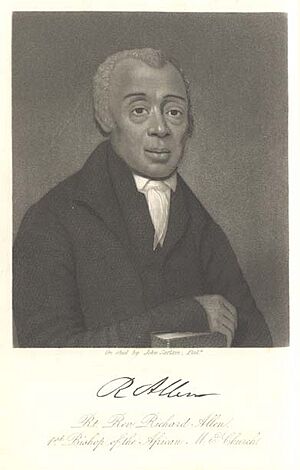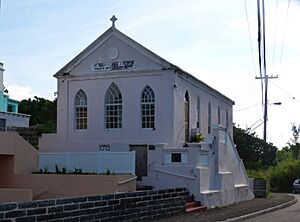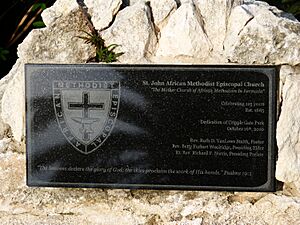African Methodist Episcopal Church facts for kids
Quick facts for kids African Methodist Episcopal Church |
|
|---|---|
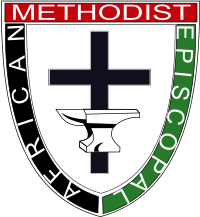 |
|
| Classification | Protestant |
| Orientation | Methodist |
| Theology | Wesleyan-Arminian |
| Polity | Connexionalism |
| Associations | World Methodist Council Wesleyan Holiness Consortium National Council of Churches (1950) World Council of Churches (1948) Churches Uniting in Christ (formerly Consultation on Church Union of 1962) Conference of National Black Churches |
| Headquarters | Nashville, Tennessee |
| Founder | Richard Allen (1760–1831) |
| Origin | 1816 (grew out of the Free African Society which was established in 1787) and Mother Bethel A.M.E. Church, (organized 1794) Philadelphia, Pennsylvania |
| Separated from | Methodist Episcopal Church (organized 1784 in Baltimore to 1939) - (currently the United Methodist Church) |
| Congregations | 7,000 |
| Members | 2.5–3.5 million |
The African Methodist Episcopal Church, often called the AME Church or AME, is a Christian church group based in the United States. It follows the Methodist way of worship and beliefs. The AME Church works with other Methodist groups around the world.
This church is known as a black church because it was the first independent Protestant church started by Black people. However, the AME Church welcomes people of all backgrounds.
The AME Church was founded by Richard Allen in 1816. He brought together five African American church groups. They wanted to escape the unfair treatment they faced in society, including in some churches. This was one of the first churches in the U.S. started because of racial reasons, not just different beliefs.
Richard Allen was chosen as the first bishop in 1816. The church grew from Philadelphia to other states like Delaware and Maryland. After the American Civil War (1861–1865), it expanded across the South and West. By 1906, the AME Church had about half a million members. It became the largest major African-American Methodist church.
Today, the AME Church has 20 areas, called districts, each with its own bishop. Thirteen districts are in the United States, mostly in the South. Seven districts are in Africa. The AME Church has about 2.5 million members worldwide. It is still one of the largest Methodist churches.
Contents
What the Name Means
The name "African Methodist Episcopal Church" tells you a lot about it.
African
The AME Church was started by people of African descent. They faced unfair treatment from white church members. The church was not founded in Africa. It is also not just for people of African descent. It welcomes everyone, but most members are black Americans.
Methodist
The church follows the Methodist tradition. Members left their old church because of discrimination. But they kept the Methodist beliefs and way of worship.
Episcopal
The AME Church is led by bishops. These bishops are the main leaders of the church.
Church History
How it Started
The AME Church grew from a group called the Free African Society (FAS). Richard Allen and others started this group in Philadelphia in 1787. They left St. George's Methodist Episcopal Church because of discrimination. They wanted a place to worship where they would be treated fairly.
Allen led a small group who wanted to stay Methodist. They formed the Bethel African Methodist Episcopal Church in 1793. They followed the beliefs and rules of the Methodist Episcopal Church. In 1794, Bethel AME was dedicated with Allen as its pastor. Allen fought in court to make sure his church could be independent.
Black Methodists in other areas also faced racism. They wanted their own churches. So, Allen invited them to meet in Philadelphia in 1816. Sixteen representatives from churches in Pennsylvania, Maryland, and Delaware met. They formed the "African Methodist Episcopal Church."
How the Church Grew
The AME Church started with eight clergy members and five churches. By 1846, it had grown to 176 clergy, 296 churches, and 17,375 members. By 1856, most of its 20,000 members were in the North. After the Civil War, membership jumped from 70,000 in 1866 to 207,000 in 1876.
The church also grew outside the U.S. It expanded to places like Bermuda. The first AME church in Bermuda was built in 1885. It was called St. John African Methodist Episcopal Church. The AME Church quickly became popular there.
Focus on Education
The AME Church has always valued education highly. In the 1800s, the AME Church in Ohio worked with a mostly white Methodist church. Together, they helped start Wilberforce University in Ohio. This was the second independent historically black college (HBCU).
By 1880, the AME Church ran over 2,000 schools, mostly in the South. These schools taught 155,000 students. They used church buildings as classrooms. Ministers and their wives often taught. Church members raised money to keep the schools going. This was important because segregated public schools often lacked funding.
Bishop Henry McNeal Turner
After the American Civil War, Bishop Henry McNeal Turner (1834–1915) became a very important leader of the AME Church. He was also active in politics. In 1863, during the Civil War, Turner was the first black chaplain in the United States Colored Troops. Later, he worked for the Freedmen's Bureau in Georgia. He helped start many AME churches in Georgia after the war.
In 1880, he was chosen as the first southern bishop of the AME Church. He was upset by the new Jim Crow laws that created segregation in the South. Turner became a leader who believed black people should consider moving to Africa.
Standing Against Racism
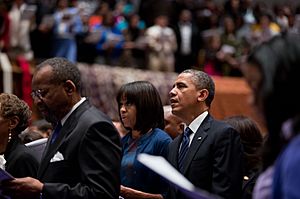
The African Methodist Episcopal Church has a special history. It was the first major religious group in the Western world that formed because of race, not just different beliefs. It was the first African-American church group officially started in the United States. The church began as a protest against racial discrimination and slavery. This fit with the beliefs of John Wesley, the founder of Methodism, who spoke out against the slave trade.
Some members of the Free African Society chose to join the Episcopal Church. They followed Absalom Jones. In 1792, they started the African Episcopal Church of St. Thomas. This was the first Episcopal church in the U.S. with a black founding group. In 1804, Jones became the first black priest in the Episcopal Church.
AME leaders and scholars have written about how their church's beliefs are shaped by the experiences of black people. They have spoken out against racism and worked for fairness.
Church Numbers
The World Council of Churches estimates that the AME Church has about 2,510,000 members. It has 3,817 pastors, 21 bishops, and 7,000 churches.
How the Church is Organized
The AME Church has a clear structure to help it run smoothly.
General Conference
The General Conference is the highest decision-making body of the AME Church. It meets every four years. It includes bishops, general officers, college presidents, and elected representatives from churches. Important speakers, like former President Barack Obama and former First Lady Michelle Obama, have spoken at these conferences.
Council of Bishops
The Council of Bishops is the church's executive branch. They oversee the church between General Conferences. They meet every year and make decisions for the church.
Board of Incorporators
This board, also called the General Board of Trustees, manages all the church's shared property. They act on behalf of the AME Church when needed.
General Board
The General Board is the main administrative body. It includes leaders from different church departments.
Judicial Council
The Judicial Council is the highest court in the AME Church. It hears appeals and is elected by the General Conference.
Bishops
Bishops are important leaders in the AME Church.
Important Early Bishops
-
Richard Allen, founder and first bishop (1816–1841)
-
William Paul Quinn, fourth bishop (1849–1873)
-
Daniel Payne, sixth bishop (1811–1893)
-
Henry McNeal Turner, twelfth bishop (1834–1915)
Current Bishops and Their Areas
- 1st Episcopal District – Bishop Samuel L. Green, Sr.
- 2nd Episcopal District – Bishop Reginald T. Jackson
- 3rd Episcopal District – Bishop Stafford J. N. Wicker
- 4th Episcopal District – Bishop Frederick A. Wright
- 5th Episcopal District – Bishop Francine A. Brookins, Esq.
- 6th Episcopal District – Bishop Michael L. Mitchell
- 7th Episcopal District – Bishop James L. Davis
- 8th Episcopal District – Bishop Erika D. Crawford
- 9th Episcopal District – Bishop Julius H. McAllister, Jr.
- 10th Episcopal District – Bishop Ronnie E. Brailsford, Sr.
- 11th Episcopal District – Bishop Marvin C. Zanders, II
- 12th Episcopal District – Bishop Silvester S. Beaman
- 13th Episcopal District – Bishop Harry L. Seawright
- 14th Episcopal District – Bishop Paul J. M. Kawimbe
- 15th Episcopal District – Bishop Henry A. Belin, III
- 16th Episcopal District – Bishop Jeffrey N. Leath
- 17th Episcopal District – Bishop Vernon R. Byrd, Jr., Esq.
- 18th Episcopal District – Bishop Jeffery B. Cooper, Sr.
- 19th Episcopal District – Senior Bishop Wilfred J. Messiah
- 20th Episcopal District – Bishop Gregory V. Eason, Sr.
- Ecumenical Officer and Endorsing Agent– Bishop David R. Daniels, Jr.
Retired Bishops
- Bishop Frank C. Cummings*
- Bishop Philip R. Cousin, Sr.
- Bishop John R. Bryant
- Bishop Robert V. Webster*
- Bishop T. Larry Kirkland
- Bishop Adam J. Richardson Jr.
- Bishop Vashti M. McKenzie
- Bishop Gregory G.M. Ingram
- Bishop Preston W. Williams, II
- Bishop Carolyn Tyler Guidry
- Bishop Julius H. McAllister, Sr.
- Bishop John F. White, Sr.
- Bishop Clement W. Fugh
- Bishop E. Anne Henning-Byfield*
- Bishop Frank M. Reid, III
* Deceased
Working with Other Churches
The African Methodist Episcopal Church works with other Methodist groups through the World Methodist Council.
In May 2012, the AME Church joined in full communion with the United Methodist Church and other black Methodist churches. This means they recognize each other's churches, share sacraments, and support each other's clergy. This brought more unity to these churches that follow the teachings of John and Charles Wesley.
Church Beliefs
The AME motto is: "God Our Father, Christ Our Redeemer, Holy Spirit Our Comforter, Humankind Our Family." This shows the main beliefs of the church.
The church's beliefs are based on the Apostles' Creed and the 25 Articles of Religion. These are shared with other Methodist churches. The AME Church also follows its own official rules, which are updated every four years. AME ministers must retire at age 75.
Social Issues
The AME Church is active in working for social justice. It has worked to improve the criminal justice system. The AME Church also supports gender equality. In 2000, it elected its first woman bishop.
The AME Church has always welcomed people of all races. It has also worked for the civil and human rights of ethnic minorities, like African Americans. It does this through community improvement and political action.
The AME Church voted in 2004 to not allow the blessing of same-sex unions. Church leaders stated that this goes against their understanding of the Bible. In 2021, the AME General Conference voted against allowing same-sex marriages in church. However, it confirmed that it does not stop LGBTQ individuals from serving as pastors or leaders. The church also voted to take a stand against climate change.
Schools and Colleges
The African Methodist Episcopal Church has been a leader in education for the African-American community.
Senior Colleges in the United States
- Allen University (Columbia, South Carolina)
- Edward Waters College (Jacksonville, Florida)
- Morris Brown College (Atlanta, Georgia)
- Paul Quinn College (Dallas, Texas)
- Wilberforce University (Wilberforce, Ohio)
Junior Colleges in the United States
- Shorter College (North Little Rock, Arkansas)
Theological Seminaries in the United States
- Dickerson-Green Theological Seminary
- Jackson Theological Seminary
- Payne Theological Seminary
- Turner Theological Seminary
Colleges and Universities Outside the United States
- African Methodist Episcopal University, Liberia
- RR Wright Theological Seminary, South Africa
Notable People
- Sarah Allen (1764–1849), Richard Allen's wife, who started the Daughters of the Conference.
- Bishop Vinton Randolph Anderson (1927–2014), the first African American to be elected President of the World Council of Churches.
- Harriet Baker (1829–1913), an early African American woman allowed to preach in the AME Church.
- Daniel Blue (1796–1884), founded the first AME church on the West Coast in California.
- John M. Brown (1817–1893), a bishop and leader in the Underground Railroad.
- Jamal Harrison Bryant (born 1971), founded Empowerment Temple (AME Church) in Baltimore.
- Bishop Richard Harvey Cain, a U.S. House of Representatives member from South Carolina.
- Daniel Coker (1780–1846), a famous preacher and abolitionist.
- Floyd H. Flake (born 1945), a former U.S. Congressman and senior pastor.
- Sarah E. Gorham, the first female missionary from the AME church.
- Bishop Carolyn Tyler Guidry (born 1937), the second female AME bishop.
- Bishop Vashti Murphy McKenzie, the first female AME bishop.
- Lyman S. Parks (1917–2009), Mayor of Grand Rapids, Michigan.
- Bishop Daniel Payne (1811–1893), a historian, educator, and the first African-American president of Wilberforce University.
- Reverdy Cassius Ransom (1861–1959), one of the founders of the NAACP.
- Hiram Rhodes Revels, the first African American to serve in the United States Senate.
- Calvin H. Sydnor III, the 20th Editor of The Christian Recorder, the AME Church's official newspaper.
- Bishop Benjamin Tucker Tanner (1835–1923), an author and editor of AME publications.
- Jarena Lee (1783–1864), the first woman preacher in the AME church with Richard Allen's blessing.
- Juliann Jane Tillman, a woman preacher in the AME Church, known for her widely reproduced portrait.
See also
- A.M.E. Church Review, a journal of the African Methodist Episcopal Church
- Religion of Black Americans
- African Methodist Episcopal Zion Church
- Black church
- Christian Methodist Episcopal Church
- Churches Uniting in Christ
- List of African Methodist Episcopal churches
- Christianity in the United States


